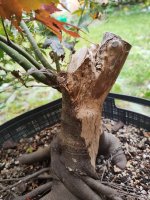MattWolf777
Seedling
- Messages
- 5
- Reaction score
- 1
Hello everyone, thank you for reading!
I bought a japaneese maple in 2025 spring for a really good price. The nebari is a beast, about 40 cm in diameter... The reason it was soo cheap is half the tree is dead...
I Do not think a wound this severe is healable...
If I were to carve the trunk out, and treated the inside with epoxy, could I keep it as a hollow trunk long term?
Is it possible to maybe graft cambium layer as a cover on the wound?
What else to do?
Thank you for answers!
I bought a japaneese maple in 2025 spring for a really good price. The nebari is a beast, about 40 cm in diameter... The reason it was soo cheap is half the tree is dead...
I Do not think a wound this severe is healable...
If I were to carve the trunk out, and treated the inside with epoxy, could I keep it as a hollow trunk long term?
Is it possible to maybe graft cambium layer as a cover on the wound?
What else to do?
Thank you for answers!





